Ijraset Journal For Research in Applied Science and Engineering Technology
- Home / Ijraset
- On This Page
- Abstract
- Introduction
- Conclusion
- References
- Copyright
AUCTIONAIRE A Blockchain Based Online Auction System
Authors: Sumeet Shelar, Shivam Sharma, Sagar Sharma, Pallavi Chandratre
DOI Link: https://doi.org/10.22214/ijraset.2022.41039
Certificate: View Certificate
Abstract
Today, the growth of electronic communication is increasing rapidly and with that, several applications are going online. This helped many businesses in gaining profit in their respective sectors. One of the various applications of electronic communication which is getting highly appreciated these days by many users is E-Auction System. E-Auction System is an effective E-Commerce system that allows bidders and sellers to interact through an online platform. This online mode has reduced many limitations of traditional auction i.e. geographical location, timing and traveling, a limited number of people, etc. In this auction system we have introduced Blockchain and smart contract as a revolutionary technology which has gain the interest of many different industries. Payment gateways are also highly secured. These technologies provide best security and make the system fully secure. Our model aim is to provide each and everyone to host their own auctions or take part in the auction from anywhere in the world. With the variation in the technology, we also have to change our self accordingly.
Introduction
I. INTRODUCTION
E-Commerce came into existence with the internet. E-Commerce was developed with the purpose of operating transactions electronically. Due to this rapid growth of e-commerce it spread into many dimensions, one of which is e-auction. Online platforms removed the limitations such as product variety and availability, deals on product and geographical barriers. E-Auction has totally changed how auctions used to work. Some of the items that go in e-auction are; flowers, antiques, signal spectrum etc. Artists use e-auction in order to sell their art where the government also uses e-auction in order to sell signal spectrums. Auctions are organized and formalized according to the auction host it is up to the auction host to set formalities like whether the winner bid has to be announced at the end or not, weather to set limitation on the number of items that could be bought or not whether the auction can be held for public bidders or private bidders like such. Some auction platforms involve centralized and third party intermediaries which raises a critical concern regarding the legitimacy of bits, the security, transparency and the integrity of the data. Blockchain is a system recording information in a way that makes it difficult or impossible to change, hack, or cheat the system and Smart Contract is a transaction protocol which is intended to automatically execute, control or document legally relevant events and actions according to the terms and condition of a contract or an agreement. These technologies provide the best security and make the system fully secure. Thus, involving blockchain and smart contract in our E-auction platform will resolve many of above discussed concerns. Also, the decentralized feature does not involve any third party or any government control. All of the work is directly happen between the bidder and seller. At the end e-auction helps both the buyer and the seller by reducing the time and the price of goods and services.
II. LITERATURE SURVEY
Franklin and Reiter, have implemented a system that works on sealed bids, i.e. the owner of the bids is unknown, until the winning bit is announced. And even after that the bidders can remain anonymous.[1] The proposed system does not have the feature of remaining anonymous, as it degrades the authenticity of the bids.
Brandt et al. proposed an approach in the paper, that for multi units auction, one might sell at a higher cost m + 1th item, that they sold for the mth item [2, 3]. The proposed system has implemented a uniform-price auction. That eliminates discriminatory auction to be held on the platform.
Cao in the paper, implemented a bit commitment and blind signature technology to build an e-auction scheme based on untrusted third parties, which degrades the credibility of the system [4]. The proposed system has integrated smart contract technology that adds further credibility to the system.
Galal and Youssef, in the paper, proposed a sealed-bid auction. The proposed scheme implemented features like validity, fairness and secrecy of the auction transaction. However, the proposed scheme depended on the third-party auctioneer [5, 6]. The proposed system does not depend upon any third-party auctioneers in order to provide a fair and valid auction.
III. PROPOSED SYSTEM
The proposed system allows users to host and take part in online auctions. Users can participate in auctions after registering in the Metamask wallet. Metamask is a software crypto currency wallet that allows users to access their Crypto currency wallet and interact with a decentralized application. After successful creation of the account user will be able to host auctions by entering the necessary details such as product name, image, description, base price, and auction duration. They can also take part in ongoing auctions by placing bids. Users can keep track of their bids from the view bids section of the website. The host can halt his/her ongoing auction before time if satisfied with the final bid price. Once an auction is ended the winner can claim his/her prize by entering the product details of that auction in the close auction section. The crypto currency used in the proposed system is MATIC token which is an Ethereum token and all the transaction is happening in MATIC network. In the future, more currencies will be added to the system. For every transaction, users will need to pay a small amount as a Gas fee. The front end of the website is created with React.js – a JavaScript framework to build component-based websites. The backend is developed with node.js and express and for the database, we have used the Ethereum network as a decentralized database. The proposed system counters the drawbacks of existing centralized systems since the data is stored using blockchain technology which ensures transparency, robustness, and immutability.
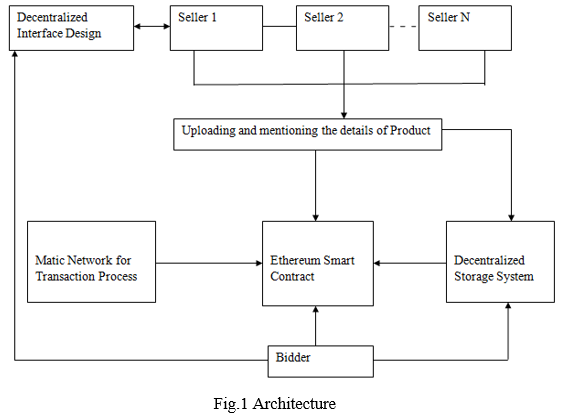
Fig.no.1 is the Design and from it, he/she will check which auction event still going on and bidder will select any one auction from which he/she wants to participate. Bidder will now see the details of product which is stored in the decentralized storage system and after viewing the details bidder will agree to the agreement of the contract by visiting the Ethereum Smart Contract. Ethereum Smart Contract is a smart contract which is simply a program that runs on the Ethereum Blockchain. The bidding can be done using the MATIC token which is a crypto currency and transaction can be done on the MATIC network after the agreement of contract. If any of the bidder bids the highest before the ending of the auction, the product will belong to him/her. After that, that auction will end and if the bidder wants to take part in any other auction which is still going on, then he/she is allowed to take part in it.
Architectural design of E- Auction model which explains the workflow of the model. E-Auction model is created in such a way that, any number of sellers and bidders can create and take part in the auction. First of all, the Sellers will interact with the Decentralized Interface Design and create the profile of him/her using his/her e-mail id. After that, he will upload the picture of the product to which he/she wants to sell. Seller will mention the details of product such as, the quality, quantity, color, category of product and base price of the product. After mentioning all the details, seller will set the date and timing of auction i.e. the starting time and the ending timing. All these details will save in the Decentralized Storage System and from decentralized storage system to Ethereum Smart Contract. Secondly, bidder will also interact with the Decentralized Interface
IV. PROPOSED FEATURES
- Host auction – A User can host an auction by filling in the necessary details such as item image, name, description, base price, auction duration.
- View auction – Users can view all the ongoing auctions with item id, name, image, base price, current bid price. Already sold items be displayed with their selling price.
- Bid in auction – Users can place their bids by filling the form with the necessary details.
- View bids – All the bids for all ongoing as well as previous auctions can be seen in a tabular format.
- Halt auction – Host can halt an auction before time and stop users from bidding.
- Close auction – The user with the highest bid can enter his/her won auction details to transfer the bid amount to the host and claim the prize.
V. SOFTWARE REQUIREMENTS
A. Software Interface Requirements
- Windows/Linux/Mac or any other OS - These are the operating system required to provide instruction to the system. Basically, they convert human language into machine language.
- Mozilla Firefox/ Google Chrome browser - These are the web browsers that enable us to access the Auctionaire website online.
B. Development Tools
- React - It is a JavaScript framework to build component-based websites. It is used to create the user interface design, so that, human and machine interaction can be possible.
- Metamask wallet - It is a software cryptocurrency wallet that allows users to access their Cryptocurrencies and interact with a decentralized application.
- Solidity - It is a high-level programming language that is used to write the program in a smart contract which is a feature of blockchain.
- Web3js - In order to interact with local and remote Ethereum nodes using HTTP, IPS, or WebSocket we used the Web3.js which is a collection of libraries.
- Nodejs - It is a JavaScript runtime that is built on Chrome. It is used in the backend to provide the connection with the front-end.
- Bootstrap - It is a CSS framework that is used to design and develop responsive websites.
VI. EXPERIMENTAL DETAILS

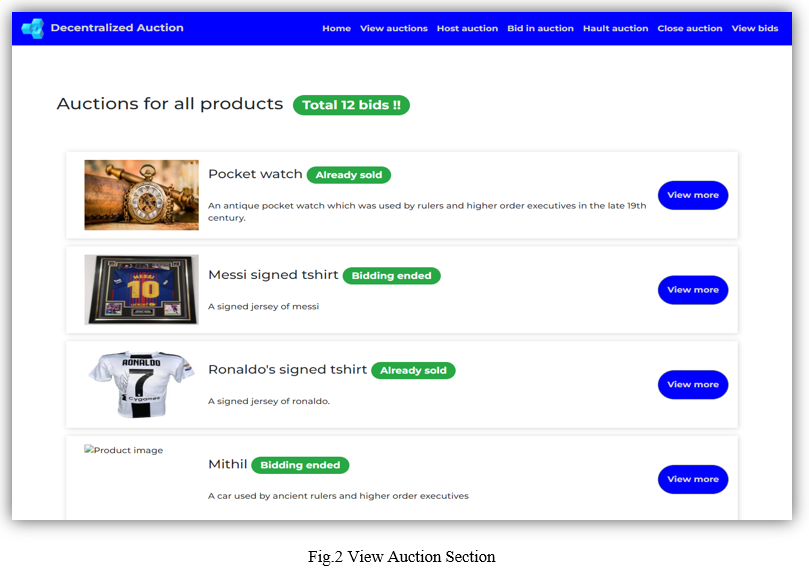
- View Auction - All the auctions, completed as well as ongoing are listed in the View auction section. Each auction has its auction status, name, short description, duration. Under View more, Clicking the bid button will redirect the user to the Bid in Auction section. As it is shown in fig 2.
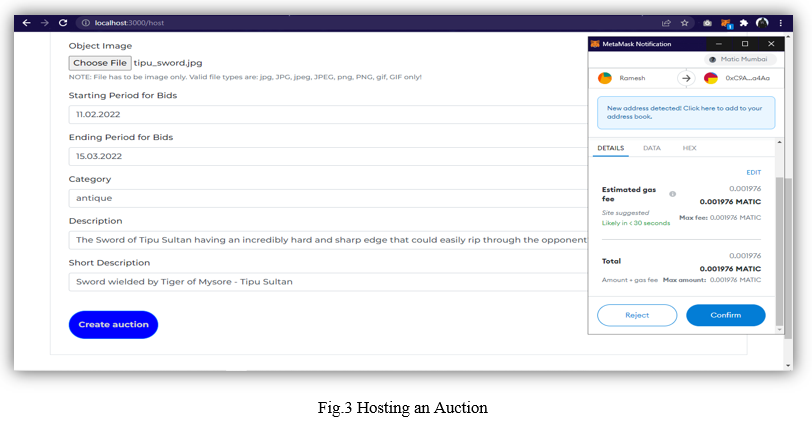
2. Hosting an Auction - After entering all the details of the auction, the host can create the auction by paying a nominal amount of gas fee as a transaction has been made on the blockchain. As it is shown in fig 3.
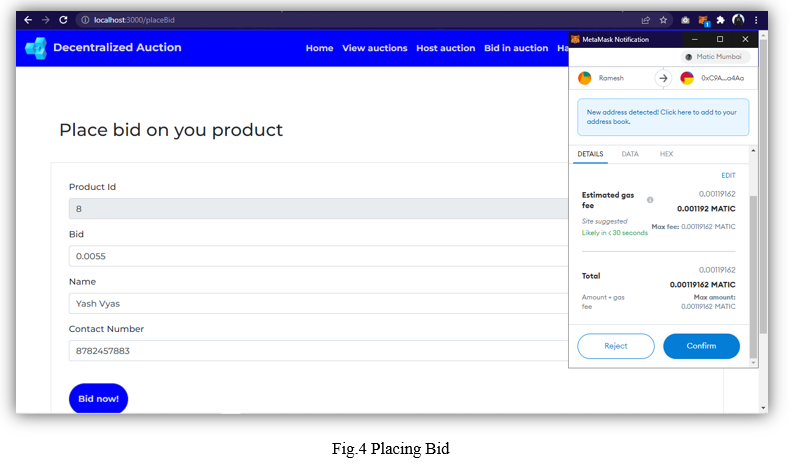
3. Placing Bid - Interested buyers can place their bids after entering the bid amount and contact details. Here a bid is placed and only the gas fee is paid. The bid amount will be transferred only if it’s a winning bid. As shown in fig.4.
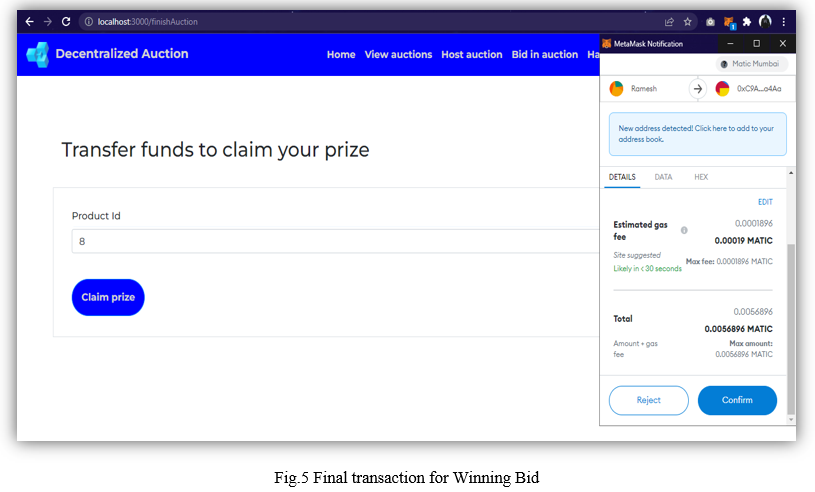
4. Final transaction for winning bid - Here, the user won the auction and now the transaction between the bidder/buyer and host/seller will take place. As shown in fig.5.
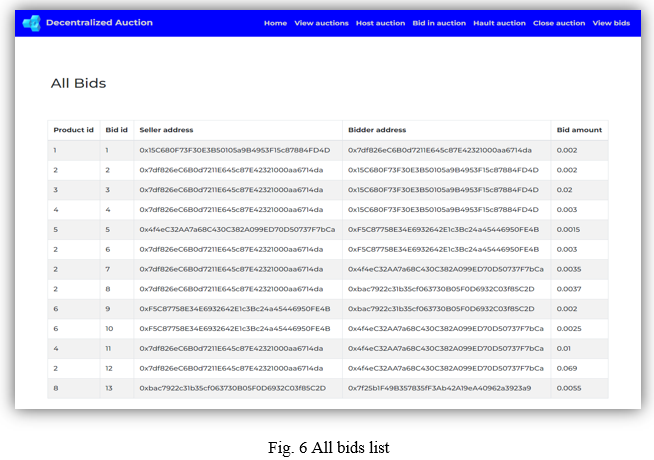
5. All bids list - In the View bids section, all the bids placed by all users to date in auctions are displayed in a tabular format. As shown in fig.6.
VII. ACKNOWLEDGEMENT
We sincerely wish to thank the project guide Prof. Pallavi Chandratre for her encouraging and inspiring guidance that helped us to make our project a success. Our project guide made sure we were on track at all times with her expert guidance, kind advice, and timely motivation which helped us determine our project. We would like to thank our project coordinator Prof. Reena Deshmukh for all the support she provided concerning our project. We also express our deepest thanks to our HOD Dr. Uttara Gogate whose benevolence helped us by making the computer facilities available to us for our project in our laboratory and making it a true success. Without his kind and keen co-operation, our project would have been stifled to a standstill.
Lastly, we would like to thank our college principal Dr. Pramod Rodge for providing lab facilities and permitting us to go on with our project. We would also like to thank our colleagues who helped us directly or indirectly during our project.
Conclusion
In this paper, we conducted a study of online auction centralized and decentralized systems available in the market. The study showed the drawbacks of traditional centralized systems and the implementation complexity of decentralized systems. Compared with the traditional auction schemes, the proposed scheme used the features of blockchain technologies to realize decentralized auctions. The risks from the third-party auctioneers were well eliminated. All the transaction information regarding the auction was encrypted with the public keys of the smart contract, which prevents information leakage. The bid price is only known to the smart contract other than published on the blockchain. Smart contract treats all bidders equally. Blockchain makes it impossible for the users from tampering with the bid data. All bidders can verify and prove their auction results with zero-knowledge proof. No user will be able to deny the bid price. The scheme is cost-effective as it was free of the cost of the third-party auctioneer, which made the biggest benefits for all auction parties. The result of this study is therefore to develop an online auction system implemented in Blockchain overcoming the drawbacks of the existing system where users can participate as well as host auctions of valuable items.
References
[1] M. K. Franklin and M. K. Reiter, “The design and implementation of a secure auction service,” IEEE Transactions on Software Engineering, vol. 22, no. 5, 1996, pp. 302–312. [2] F. Brandt and T. Sandholm, “Efficient privacy-preserving protocols for multi-unit auctions,” in Proceedings of the 2005 Financial Cryptography & Data Security, Financial Cryptography and Data Security, Springer, February-March 2005, pp. 298–312. [3] F. Brandt, “How to obtain full privacy in auctions,” International Journal of Information Security, vol. 5, no. 4, 2006, pp. 201–216. [4] G. Cao, “Electronic auction scheme based on trust less third-party,” Computer Engineering, vol. 36, 2010, pp. 140–144. [5] H. S. Galal and A. M. Youssef, “Verifiable sealed-bid auction on the Ethereum blockchain,” in Proceedings of the 2018 Financial Cryptography, Springer, March 2018, pp. 265–278. [6] H. S. Galal and A. M. Youssef, “Succinctly verifiable sealed-bid auction smart contract,” in Proceedings of the 2018 Data Privacy Management, Cryptocurrencies and Blockchain Technology, Lecture Notes in Computer Science, Springer, September 2018, pp. 3–19.
Copyright
Copyright © 2022 Sumeet Shelar, Shivam Sharma, Sagar Sharma, Pallavi Chandratre. This is an open access article distributed under the Creative Commons Attribution License, which permits unrestricted use, distribution, and reproduction in any medium, provided the original work is properly cited.

Download Paper
Paper Id : IJRASET41039
Publish Date : 2022-03-27
ISSN : 2321-9653
Publisher Name : IJRASET
DOI Link : Click Here
 Submit Paper Online
Submit Paper Online

